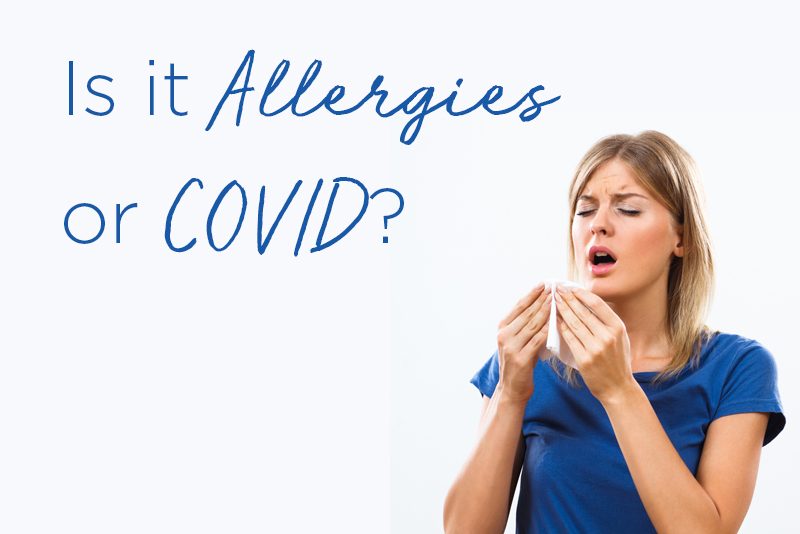It’s that time of year again. Many of us are coughing, snorting, sneezing and generally not feeling our best. Even if you deal with this every year – or multiple times per year – this year, thanks to COVID many of us are wondering, is it allergies or COVID? Either way, there are two nutrients that should be part of your first line of defense against allergies and viral risk.
Polyphenols and Ascorbate (Vitamin C)
Polyphenols (flavonols and flavonoids) are a group of chemical compounds found in plants that provide much of the flavor, color, and taste to fruits, vegetables, seeds and other parts of the plant. These compounds are best known for their antioxidant and anti-inflammatory health benefits as well as support of the cardiovascular and nervous systems.
One of the best-studied polyphenols is the flavonoid quercetin, naturally occurring in onions, apples, capers, dill, cilantro, and many other herbs, vegetables, and fruits. In addition to its antioxidant and anti-inflammatory benefits, it is particularly useful at this time of year because of its significant antihistaminic, i.e., anti-allergy, effects. Quercetin prevents activation and recruitment of mast cells while stabilizing their membranes and blocking subsequent degranulation – which is very important for managing Type 1 or immediate allergies.
All quercetins, however, are not alike. Poor bioavailability or toxicity make many forms inappropriate for health management. Quercetin “dihydrate” is the preferred form to use. While certain studies and experiments show that quercetin dihydrate is insoluble in water, what really matters is how it functions in the body. In physiologic or biological salt solutions as present in cells and tissues, it is easily available, especially to the immune first responder cells. Flavonols like Oligomeric proanthocyanidins (OPC) work hand in hand with quercetin dihydrate to enhance antioxidant benefit.
Don’t Forget the Ascorbate
To be effective in the body, all polyphenols like quercetin require adequate ascorbate intake. Fully buffered ascorbates and flavonoid/flavonol complexes work synergistically as complementary antioxidants, they are anti-histaminic in nature and immunomodulatory in design.
Quercetin dihydrate behaves in a similar fashion to reduced glutathione in the body;
it preserves the integrity of ascorbate by enhancing the reduction of the intermediary compound dehydroascorbic acid (oxidized ascorbate) back to fully reduced ascorbate.
Ascorbate itself acts as an antioxidant and free-radical scavenger that keeps undesired metabolites from accumulating.
These attributes of ascorbate and polyphenols are especially important as their use together can tackle seasonal allergies and can be a game changer for COVID-19 support as well.
PERQUE Repair Guard and PERQUE Pain Guard Forte’ deliver quercetin dihydrate with soluble oligomeric proanthocyanidin (OPC). We recommend between 0.5 and 20 grams for superior oxidative stress reduction, protection of cellular machinery, and to activate repair. By performing a C-cleanse regularly and taking the recommended amount of PERQUE Potent C Guard, you can ensure optimum polyphenol utilization. We recommend supplementing 1 g of polyphenols for every 5 g of ascorbate needed.
Polyphenolics and ascorbate are vital components of our viral risk reduction recommendations. Visit our Coronavirus Resource Center to learn more and download Dr. Jaffe’s eBook.
Note About Allergies
The coughing, snorting and sneezing mentioned above are a result of IgE mediated reactions. The triggers of these type I immediate allergies are usually easy to identify because reactions occur soon after exposure (usually within minutes to 3 hours). Identifying a trigger to which you were exposed up to 3 weeks ago is much more challenging, but equally important. Only by identifying the delayed hypersensitivities and avoiding the offending substances, are you able to restore immune resilience and optimal protection from true threats.
To learn more about the specialized test to identify these delayed (type II, III, IV hypersensitivity) allergies visit ELISAACT.com.
Did you enjoy this post? We post new content regularly! Click here to see our latest blog posts.


